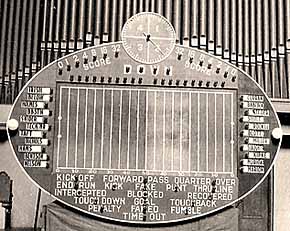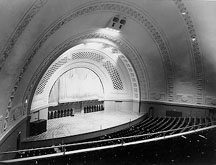
The First "Broadcast" of a UM Football Game
Interest in Michigan football grew steadily among the student body and the state's population at large during the 1890s and reached new heights with the success of Fielding Yost's "point-a-minute" teams. Special fan trains were arranged for many away games, but only a few supporters were able to make the trips. Those left behind could get full accounts of the action in the next day's newspaper, but for many that was not quick enough. For a number of years the Michigan Daily maintained a scoreboard on campus. Reporters telegraphed results to the Daily office which were then posted on the scoreboard. For big games, sizable crowds would gather at the scoreboard to get "up-to-the-minute" results.
In 1903, a UM student, the Athletic Association and the Bell Telephone Company teamed up to bring Wolverine fans in Ann Arbor a nearly "live" account of the Minnesota game played on October 31 in Minneapolis; a game that would determine the "Champion of the West." Reporting the game from a specially built tower at Northrop Field, Floyd (Jack) Mattice, Law 1905, could lay a justifiable claim to being one of the first broadcasters of a college football game.

Floyd (Jack) Mattice,
UM-Law 1905, provided
first "live" play-by-play
account of a UM football
game in 1903.
A native of Lima, 0hio, Mattice learned the Morse telegraphic code as a youngster, and he could handle it well enough to hold down summer jobs as a telegrapher with the railroads and Western Union.
As a Michigan student with a keen interest in Wolverine football, he turned this knowledge to use. He sold Western Union the idea of allowing him to telegraph his own play-by-play account of Michigan games from the press box, instead of waiting for handwritten copy from reporters. This idea was adopted to speed up transmission to newspapers throughout the nation.
On campus, the telephone company ran special phone lines to the University Hall Auditorium. In Minneapolis, Bell engineers erected a wooden tower 40 feet high at the 55-yard line (football was played on 110-yard fields in those days). On top of the tower was a wooden telephone booth.
Mattice climbed the tower, entered the booth and donned a headset and voice transmitter. When he spoke into the transmitter, he was answered by a professor speaking from University Hall in Ann Arbor. Some 3,000 persons were assembled there to hear Mattice's description of the game. The Bell company had several other cities hooked in on the same broadcast.
As Mattice looked down upon the field through binoculars he described the progress of the game, just as fans now are advised of game details by radio broadcasters or TV announcers.
Nobody ever had seen a football game from this vantage point and it's possible Mattice saw things the field-bound coach and spectator never had witnessed before. If he did, it all went into his report.
Back in Ann Arbor, the University Hall fans, who had paid a 25 cent admission fee, eagerly awaited Mattice's report. Since in that time there was no radio, no loudspeakers or no way to amplify telephone transmissions, and head phones could not be supplied for all the listeners, an ingenious system was worked out, according to Mattice. The Bell engineers placed 10 telephones on 10 tables backstage in University Hall. Ten students, who knew football and the opposing teams, sat at the tables in numbered order.
The first student listened to as much of Mattice's description as he could remember, dropped the receiver and rushed to the stage. By megaphone he told the crowd what Mattice had said. Meanwhile, the second student had picked up Mattice's conversation and in his turn rushed to the stage while the third man listened to the description of the play from distant Minneapolis. In this manner the 10 students dashed back and forth to transmit the description. The course of the game was also charted on a large diagram of a football field on the auditorium stage. As play progressed a marker charted the position of the ball.
It may sound primitive now but to the football fans of that bygone era, it was nothing short of miraculous to know what was going on at such a distant point almost at the same time it happened.

The Auditorium at University Hall, pictured at left, was filled to capacity to hear Floyd Mattice's account of the action in the 1903 Minnesota game. University Hall, situated where Haven and Mason Halls now stand, was home to the Department of Literature, Sciences and the Arts and university administrative offices. The auditorium was the principal campus site for concerts, lectures and university assemblies. The Frieze Memorial Organ was moved to Hill Auditorium in 1913.
On Thanksgiving Michigan played Amos Alonzo Stagg's team at Chicago and the same system was used, except that there was no tower. Mattice walked along the sidelines with his transmitter.
This system was used effectively until the 1920s when football radio broadcasting had its inception. In 1913 the site of these "broadcasts" moved to Hill auditorium and more elaborate "grid-graphs" were devised to track the progress of the ball. As the Michigan Daily described the setup for the 1924 game with Michigan Agricultural College (Michigan State), a special Western Union telegraph wire was installed in Hill Auditorium and a "gridgraph in the form of a large oval representing a pigskin on which the game is reproduced by means of lights" was set up on stage. In addition to the gridiron over which the ball is moved, "the names of all players are displayed on each side, the name of the player making the play being lighted up. At the bottom of the board is shown what kind of play is made while the quarter and yardage is shown at the top."
Nearly 3000 students and fans gathered at Hill to hear and watch the "live" account of Michigan's 7-0 win in the game dedicating the "Aggies" new stadium. And lively they were. According to the Daily account,
"Groans went up when Michigan failed in her efforts and cheers and yells greeted every movement of the lights which indicated the position of the ball.
Cheer after cheer was led by the cheerleaders, the crowd responding enthusiastically. When the touchdown was made, people stood on seats and yelled, old men waved their arms frantically and ladies joined in the cheering."

Grid Graph at Hill Auditorium for the 1923
Wisconsin Game
The MAC game marked a turning point for the gridgraph and the gatherings in Hill Auditorium. While the raucous crowd cheered on their team in the stately concert hall, a smaller group was assembled in the Tap Room of the Michigan Union listening to the first broadcast of a Michigan game on the Union's newly installed radio. The first broadcast originating from Ferry Field came two weeks later when E. L. (Ty) Tyson, widely-known broadcaster from Detroit, described the Wisconsin game for station WWJ from a seat in the east bleachers. Despite the new competitor, the gridgraph remained a popular feature of campus life through the 1929 season.
 Hill Auditorium, a world class concert hall, hosted the telephone and telegraphic "broadcasts" and "gridgraph" recreations of football game action from 1913 to 1929. The Majestic Theater in Ann Arbor sometimes offered a competing "broadcast" and a Detroit venue usually reproduced the game as well. Into the 1960s, long after the gridgraph was superceded by radio and television, Hill Auditorium continued to host Varsity Night and pep rallies before homecoming and other big games.
Hill Auditorium, a world class concert hall, hosted the telephone and telegraphic "broadcasts" and "gridgraph" recreations of football game action from 1913 to 1929. The Majestic Theater in Ann Arbor sometimes offered a competing "broadcast" and a Detroit venue usually reproduced the game as well. Into the 1960s, long after the gridgraph was superceded by radio and television, Hill Auditorium continued to host Varsity Night and pep rallies before homecoming and other big games.
The 1903 Minnesota game "broadcast" by Mattice is now best remembered as the origin of "The Little Brown Jug" trophy. The game, recalled by participants as one of the most bitterly contested of the era, ended in a 6-6 tie, the only blemish on Fielding Yost's record from 1901-1904. Michigan left a water jug on the field and the Minnesota coach later challenged Yost to come back and win the jug. It would be six years before the teams played again, but Michigan did win its jug back in 1909, initiating one of the most famous trophy competitions in college football.
Floyd Mattice, went on to a long career as an attorney with the United States Justice Department. In 1966, at the age of 84 he related his story of that first "broadcast" for an article in the Minnesota game football program. He marveled at the distance we had come "from the 40-foot tower at the Michigan-Minnesota game of 1903, to today's zoom lenses and nationwide broadcasts of athletic events." Surely he would be even more amazed today.
[This story is based in part on an article that appeared in the 1966 Minnesota game program.]
Image Credits:
- Floyd Mattice BHL, senior photo, 1904 Michiganensian
- University Hall Auditorium - BHL, Photo Vertical File, University Hall
- Gridgraph at Hill, photo courtesy of Wystan Stevens
- Hill Auditorium - BHL, Photo Vertical File, Hill Auditorium
top | previous | next
| Stadium Home Page | Ath. Dept. MGOBLUE |
Ath. History | Bentley Library

